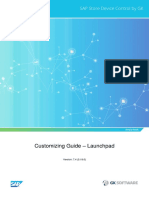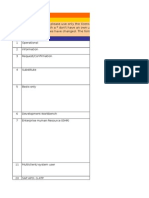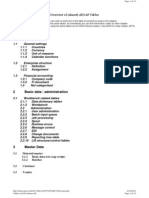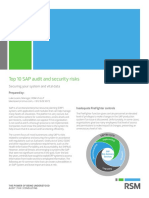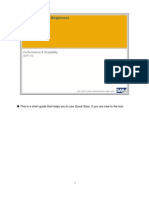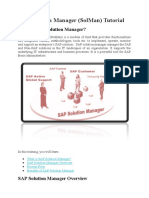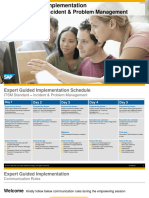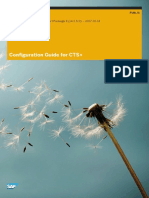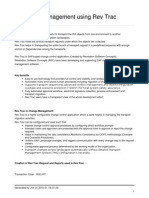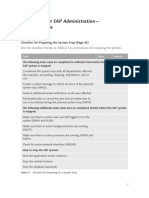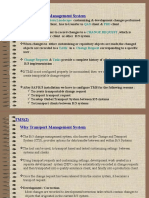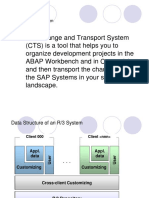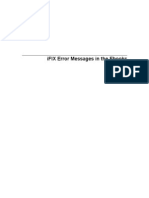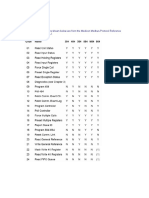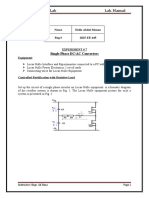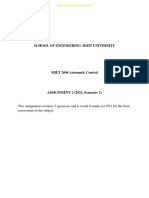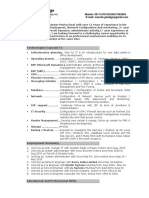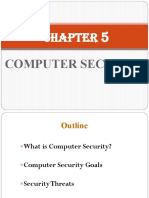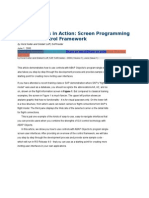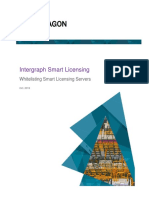Introduction to Transport Management
System (TMS)
Why do we need a Transport System?
The CTS components play an important role in the overall development and customization
environment.
CTS is an instrument for:
Administering & controlling new development requests.
Managing transports
Recording of where and by whom changes are made
Configuring systems landscape
Overview of CTS Components
CTO (Change and Transport Organizer) Its the main tool for managing,
browsing, and registering the changes done on the repository and customizing objects.
Its the central point for organizing the development projects. SE01 is the transaction
with new extended view.
(TMS) Transport Management System Is used to move, manage, control, copy
development objects and customizing settings in an orderly fashion across SAP
systems in a landscape through pre-defined transport routes (RFC Connections). The
transport process basically consists of exporting of objects out of the source SAP
system and importing them into the target SAP system/s.
Transport Tools The actual transports happen in the back-end at the OS level using
transport tools, which are part of SAP Kernel and includes the program R3trans and
the transport control program tp.
SAP System-Landscape
The system landscape (also known as SAP System Group) is the arrangement of SAP servers.
Ideally, in an SAP environment, a three-system landscape is recommended. It consists of the
1. Development Server DEV
2. Quality Assurance Server QAS
3. Production Server PRD.
Transport cycle in a very basic sense, is the release of new Developments/ Customizing
Changes from DEV which are imported in both Quality and Production systems. However,
import in PRD can happen only once integration testing and quality check has been performed
in QAS (and marked as checked).
What is Customizing? How does TMS help in Customizing
Customizing is a process to adapt the SAP system according to the customers need.
To perform the customizing, users and consultants take help of SAP Reference
Implementation Guide (IMG), which is accessible through transaction SPRO.
Customizing is ideally done in DEV. The Transport Organizer (SE01) is used in
conjunction with IMG to record and transport customized changes further.
Most of the Customizing changes (though, not all) are client-specific, i.e., the changes are
supposed to be reflected in a particular client only and not intended for all the system clients.
When the Transport Request is exported, it extracts the relevant table entries from the
database of the SAP system and copies them to the transport directory. Relevant table entries
are locked when the customizing transaction is being used. However, they are unlocked as
soon as the changes are saved to a Transport Request.
Repository and Development Changes
Apart from customizing already existing objects, new developments are also required
in most of the cases. Development object is any object that is created (developed) by
you in SAP system.
Collection of all such objects (client-specific or cross-client) is called Repository.
Development is mostly done with the help of ABAP Workbench (SE80), therefore
such changes are also known as Workbench Changes.
Examples:
o ABAP Dictionary Objects: Tables, Domains, Data elements, etc.
o ABAP Programs, function modules, menus, screens
o Documents, Application defined transport-objects, etc.
Workbench is also fully integrated with TMS, to record and transport the changes.
Most of the Workbench changes (though, not all), are cross-client, i.e. changes will be
reflected in all the system clients of the target system. Objects transported from the source
system overwrite objects in the target system that has the same names.
Clients and the type of Data in SAP System
Conceptually, client is a technical and organizational independent unit, that contains
its own set of data (Master Data, Application/ Operational data, Customizing Data)
Clients create separate environments for users from different user groups or with a
different purpose, within same SAP system, without actually using different database.
From Technical point of view, client is specified using 3-digit numeric ID, which also
acts as the value for the table field MANDT, in case of client-specific jobs.
Among client specific data, there are 3 types of data:
User Master Data contains the user login information, including the username, the
password and the user defaults, the authorization profiles or roles, and the other useful
information such as user groups, communication and so on. This data is physically
present in a specific set of tables (the USR* tables).
Customizing Data contains the configuration settings to customize organizational
structure and the business processes for the companies implementing SAP. This data
is client dependent and is stored in tables known as customizing tables.
Application Data are also client dependent and normally users distinguish two types
master data and transactional data.
1. Master Data such as vendor master, material master (tables such as
MARA)
2. Transactional data such as sales order, financial documents, Production
Orders (POs) and so on.
Client Customization Options
Transport Directory and Its configuration
SAP Transport Directory:
It is the global transport directory (/usr/sap/trans), which is actually a shared location
(residing in the Domain Controller System) among all the member systems of a
landscape (system group) .It also contains certain subdirectories, that are created
automatically during the installation of the SAP system. This is mandatory for setting
up the Transport Management System.
Basically, Transport Directory is the location where all the changes are saved (in the
form of files) after they are released from DEV. Therefore, it acts as a source for the
changes to be eventually imported in DEV and PRD. Hence, we have to make sure
that the transport directory is shared properly among all the systems in a landscape.
As an example, in Windows NT, the shared directory location can be accessed using the
following address: \<SAPTRANSHOST>sapmnttrans where SAPTRANSHOST (Domain
Controller Systems address) is defined in hosts file in Windows Directory of all SAP systems
in the landscape. Domain Controller is one of the systems in a landscape that act as an
overall controller for change management and transport process in the landscape. Domain
Controller is chosen (out of D / Q / P) by the team of system administrators, on the basis of
system availability and the time of installation.
Main Subdirectories:
Cofiles: Contains Change Request Information files with complete details and
commands.
Data Files: Contains the actual values and data to be used in implementing the
change.
Log: Contains Transport logs, traces or statistics, used for trouble-shooting, in case
any error occurs in the transport process.
EPS: Download directory for advanced corrections and support packages
Other Subdirectories are:
bin: Configuration files for tp (Transport Program) and TMS
olddata: Old Exported Data for archival or deletion
actlog: Action logs for all requests and tasks
buffer: Transport buffer for each system declaring the transports to be imported
sapnames: Information regarding transport requests made by respective users
tmp: Temporary and data log files
Setting up of Transport Directory and TPPARAM
While configuring TMS, one of the main pre-requisite is to setting up the Transport
Directory and the Transport Parameter file.
It ensures that the Directory is shared properly among all the systems in a Landscape,
for that all the systems taking part in the group/landscape are to be included in the
global configuration file TPPARAM (transport parameter file), located under the bin
subdirectory of /use/sap/trans. We have to make sure that the entries for all the
participating systems are made in this file.
In case, any entry is missing, copy another systems entry and change the values (for
instance, System ID, Host name)
At the time of installation, transport directory & the sub-directories are created
automatically, including an initially configured template of TPPARAM file.
Operating System Tools TP and R3trans
tp The Transport Control Program:
tp is the SAP program that administrators use for performing and planning transports
between systems and also in upgrades of the SAP systems. This is used by the CTO
and TMS.
Actually, tp uses other special tools/programs and utilities to perform its functions.
Mainly, it calls R3trans utility program. However, it also offers a more extensive
control of the transport process, ensuring the correct sequence of the
exported/imported objects, to avoid severe inconsistencies in the system, which may
arise due to wrong sequence.
tp is located in the standard runtime directory of the SAP system:
/usr/sap/SYS/<SID>/exe/run. It is automatically copied in the installation process.
As a pre-requisite, the tp global parameter file (TPPARAM), must be maintained,
specifying at least, hostnames of the systems taking part in the transport process.
tp is mainly used for performing imports in target systems. It uses utilities called
Import Dispatchers RDDIMPDP & RDDIMPD_CLIENT_<nnn>, these are ought
to be scheduled as background jobs in every system where imports will be performed.
If for any reason they are deleted, we can schedule these jobs by running report
RDDNEWPP.
These jobs are actually event triggered, meaning that tp sends a signal (an event) to
the R/3 system and the job starts. These events are named as
SAP_TRIGGER_RDDIMPDP and SAP_TRIGGER_RRDIMPDP_CLIENT.
R3trans The Transport Control Program:
R3trans is the SAP system transport program that can be used for transporting data
between different SAP systems. It is normally not used directly, but called from the tp
control program or by the SAP upgrade utilities.
tp controls the transports and generates the r3trans control files, but does not connect
to the database itself. All the real work is done from R3trans.
It supports the transporting of data between systems running on different OS and even
different DB.


